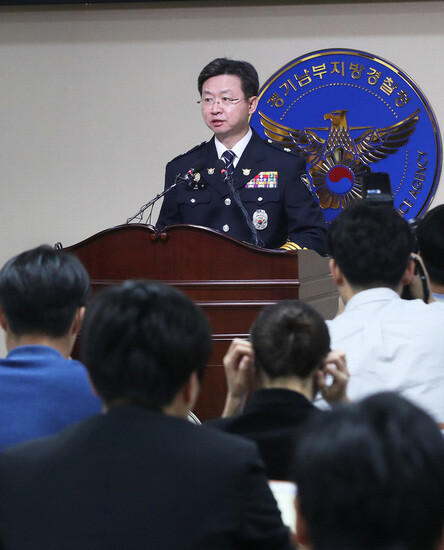hankyoreh
Links to other country sites 다른 나라 사이트 링크
Police find direct link between suspect and deaths in Hwaseong serial murders cases in 1986-1991

A 56-year-old surnamed Lee who is seen as a likely suspect in a series of murders in Hwaseong, Gyeonggi Province, was found to have direct connections with three of the eight deaths. Thirty-three years after the last reported attack, advancements in DNA analysis and scientific investigations since the murders took place are now offering pivotal clues in what has become one of South Korea’s most famous unsolved mysteries.
In a Sept. 19 briefing presiding over by Second Division Chief Ban Gi-su, the Gyeonggi Nambu Provincial Police Agency explained, “Mr. Lee’s DNA matched DNA taken from evidence of three of the Hwaseong cases.” Specifically, traces of Lee’s DNA were found in evidence from the fifth (January 1987), seventh (September 1988), and ninth (November 1990) murders. In the case of the ninth murder, Lee’s DNA was found in the female victim’s underwear. Lee denied involvement with the crimes while being questioned in jail after the results showing a match with DNA from the evidence, police said.
The DNA in question was confirmed through a database of prisoner and other DNA maintained by the Supreme Prosecutors’ Office (SPO). In accordance with the Act on Use and Protection of DNA Identification Information (implemented in July 2010), DNA samples are stored for convicts in 11 categories who are seen as at high risk for repeat offenses, including murder and sexual assault.

The prisoners’ and other DNA is managed by the SPO, while DNA collected from suspects in custody and crime scenes is administered by the police (the National Forensic Service, or NFS). Lee’s DNA sample was collected in October 2011 and registered in the database in January 2012. Police sent stored evidence from the case to NFS for re-analysis, and the NFS identified Lee as a strong suspect based on a comparison with SPO-administered prisoner DNA.
In a December 2018 examination at the request of the Suwon District Prosecutors’ Office, SPO detected the Y chromosomes of two males on a ballpoint pen from the personal effects of the ninth victim in the Hwaseong serial murders. But only trace amounts were detected, and no specific suspect could be identified. Prosecutors also said they were unable to confirm whether the DNA matched Lee’s.
The three cases for which Lee’s DNA was detected share some similarities in terms of criminal method and the body’s location: the victims’ underwear was used to bind their hands and feet after the crime, and the bodies were found on a farm road or hill. The body of the fifth victim, an 18-year-old woman surnamed Hong, was discovered bound with a stocking in a rice paddy in Hwanggye, a village in Hwaseong’s Taean Township. The body of the seventh victim, a 52-year-old woman surnamed Ahn, was similarly found in a farm waterway in Gajae Village, Paltan Township, with both hands tied with a blouse. The victim of the ninth murder in Taean’s Byeongjeom No. 5 Village, a 13-year-old girl surnamed Kim, was found on a hill bound with a stocking.
“We’ve sent evidence from the other cases to NFS for DNA analysis, although we don’t know when the findings will come out,” said an official with the Gyeonggi Nambu Provincial Police Agency.
By Kim Gi-seong, South Gyeonggi correspondent, Lee Jung-ha, Incheon correspondent, Oh Yoon-joo, Cheongju correspondent, and Choi Woo-ri, staff reporter
Please direct comments or questions to [english@hani.co.kr]

Editorial・opinion
![[Column] Life on our Trisolaris [Column] Life on our Trisolaris](https://flexible.img.hani.co.kr/flexible/normal/500/300/imgdb/original/2024/0505/4817148682278544.jpg) [Column] Life on our Trisolaris
[Column] Life on our Trisolaris![[Editorial] Penalties for airing allegations against Korea’s first lady endanger free press [Editorial] Penalties for airing allegations against Korea’s first lady endanger free press](https://flexible.img.hani.co.kr/flexible/normal/500/300/imgdb/original/2024/0502/1817146398095106.jpg) [Editorial] Penalties for airing allegations against Korea’s first lady endanger free press
[Editorial] Penalties for airing allegations against Korea’s first lady endanger free press- [Editorial] Yoon must halt procurement of SM-3 interceptor missiles
- [Guest essay] Maybe Korea’s rapid population decline is an opportunity, not a crisis
- [Column] Can Yoon steer diplomacy with Russia, China back on track?
- [Column] Season 2 of special prosecutor probe may be coming to Korea soon
- [Column] Park Geun-hye déjà vu in Yoon Suk-yeol
- [Editorial] New weight of N. Korea’s nuclear threats makes dialogue all the more urgent
- [Guest essay] The real reason Korea’s new right wants to dub Rhee a founding father
- [Column] ‘Choson’: Is it time we start referring to N. Korea in its own terms?
Most viewed articles
- 1New sex-ed guidelines forbid teaching about homosexuality
- 260% of young Koreans see no need to have kids after marriage
- 3[Column] Life on our Trisolaris
- 4OECD upgrades Korea’s growth forecast from 2.2% to 2.6%
- 5Presidential office warns of veto in response to opposition passing special counsel probe act
- 6Months and months of overdue wages are pushing migrant workers in Korea into debt
- 7[Guest essay] Maybe Korea’s rapid population decline is an opportunity, not a crisis
- 8[Editorial] Penalties for airing allegations against Korea’s first lady endanger free press
- 9[Reportage] On US campuses, student risk arrest as they call for divestment from Israel
- 10Korea sees more deaths than births for 52nd consecutive month in February